Inverted L-shape association between a body shape index and peak expiratory flow among middle-aged and older adults: findings from the China Health and Retirement Longitudinal Study (CHARLS)
- PMID: 40382617
- PMCID: PMC12084908
- DOI: 10.1186/s12944-025-02599-2
Inverted L-shape association between a body shape index and peak expiratory flow among middle-aged and older adults: findings from the China Health and Retirement Longitudinal Study (CHARLS)
Erratum in
-
Correction: Inverted l‑shape association between a body shape index and peak expiratory flow among middle‑aged and older adults: findings from the China Health and Retirement Longitudinal Study (CHARLS).Lipids Health Dis. 2025 Aug 27;24(1):268. doi: 10.1186/s12944-025-02678-4. Lipids Health Dis. 2025. PMID: 40859332 Free PMC article. No abstract available.
Abstract
Background: Peak expiratory flow (PEF) serves as a direct indicator of the functional status of the respiratory system. Higher body fat content, especially abdominal obesity, may relate to a deterioration in long-term respiratory function. The "A Body Shape Index" (ABSI) better assesses abdominal obesity, but its association with PEF is poorly understood.
Methods: The analysis demonstrated data from 14,386 middle-aged and older adults from the 2015 China Health and Retirement Longitudinal Study (CHARLS). ABSI, a sex-specific metric integrating waist circumference, weight, and height via allometric modeling derived from Chinese anthropometrics, was analyzed against PEF/PEF prediction using multivariable linear and spline regressions to characterize nonlinear associations. Threshold effects, subgroup, and sensitivity analyses ensured robustness.
Results: This research showed a negative relationship between ABSI and both PEF and PEF predictions. An inverted L-shaped curve in the spline analysis characterized the association between ABSI and PEF/PEF prediction across the sexes. The ABSI threshold was 0.0782 and 0.0691 in males and females, respectively.
Conclusions: Abdominal obesity negatively affects respiratory function, with ABSI thresholds varying by sex. Therefore, weight management should focus on a healthy ABSI to reduce abdominal obesity and safeguard respiratory health.
Keywords: A body shape index; Abdominal obesity; Peak expiratory flow; Respiratory function tests.
© 2025. The Author(s).
Conflict of interest statement
Declarations. Ethical approval and consent to participate: Ethical approval was obtained from the Institutional Review Boards of Peking University (No. IRB00001052-11015) for the CHARLS, and all participants gave informed consent. Consent for publication: All authors have reviewed the final version of the manuscript and approve its submission for publication. Competing interests: The authors declare no competing interests.
Figures



References
MeSH terms
LinkOut - more resources
Full Text Sources

